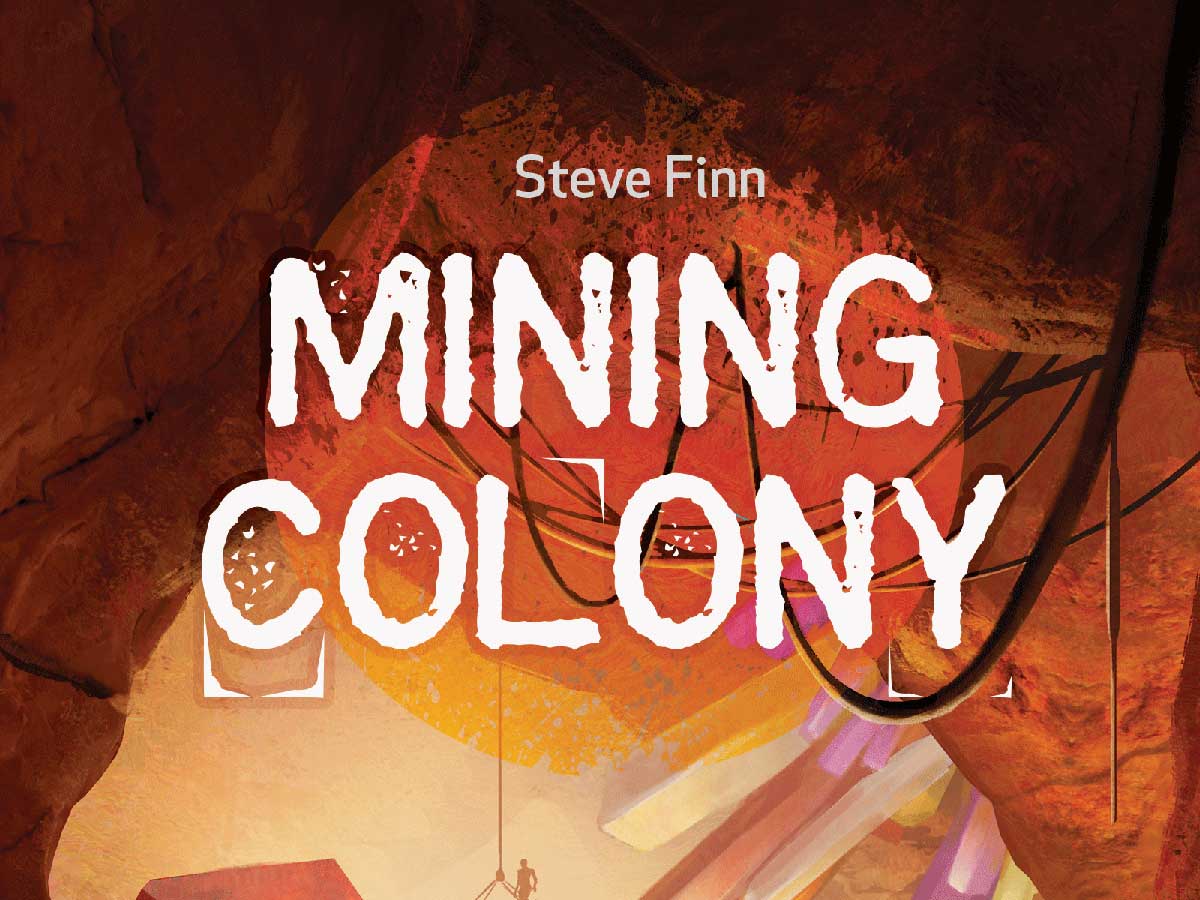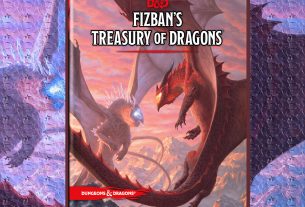Okay, maybe it’s not the red planet, but it is certainly a red planet. Either way, you’re here to build mines to support your resource-starved home planet, so you better get to work!
What Is Mining Colony?
Mining Colony is a tile-placement game for 1 to 4 players, ages 14 and up, and takes about 40 minutes to play. It’s currently seeking funding on Kickstarter, with a pledge level of $24 for a copy of the game. (If you pledge for other games as well, the price per game goes down.) Although the box says 14 and up, I actually played this with my 7-year-old as well and she was able to learn the rules; I’m guessing that the age recommendation has more to do with materials testing and regulations than the actual gameplay and complexity.
Mining Colony was designed by Steve Finn and published by his own company Doctor Finn’s Games, with illustrations by Marius Janusonis and graphic design by Kim Robinson. It’s part of a Kickstarter campaign that includes the 2021 lineup for Doctor Finn’s Games, though I will only be covering Mining Colony myself.
New to Kickstarter? Check out our crowdfunding primer.

Mining Colony Components
Note: My review is based on a prototype copy, so it is subject to change and may not reflect final component quality.
Here’s what comes in the game:
- 4 Colony boards
- 48 Excavation cards (12 per player)
- Game board
- 50 Development tiles (10 each in 5 sizes)
- 30 Build-Over tokens (in 4 types)
- 10 Resource cards
- 15 Workers (5 each in 3 colors)
- 15 Ships (5 each in 3 colors)
- 9 Outposts (3 each in 3 colors)
- 48 Crystals (12 each in 4 colors)
- 12 Science Stations (3 each in 4 colors)
- 25 Credit tokens
- Score pad

Mining Colony is a pretty compact game overall. The main game board folds in half, and the excavation cards are half-sized cards (while the resource cards are full-size).
There are illustrations on the excavation cards and the game board, though it’s a shame that the landscape illustration on the board is usually covered up by tiles and cards throughout the game. The excavation cards have various illustrations, which are just for flavor and don’t really represent anything specific in terms of gameplay.

Everyone gets a set of 12 excavation cards with a range of values, and they’re done in a way so that there aren’t any duplicate numbers, ensuring that there’s never a tie between players.
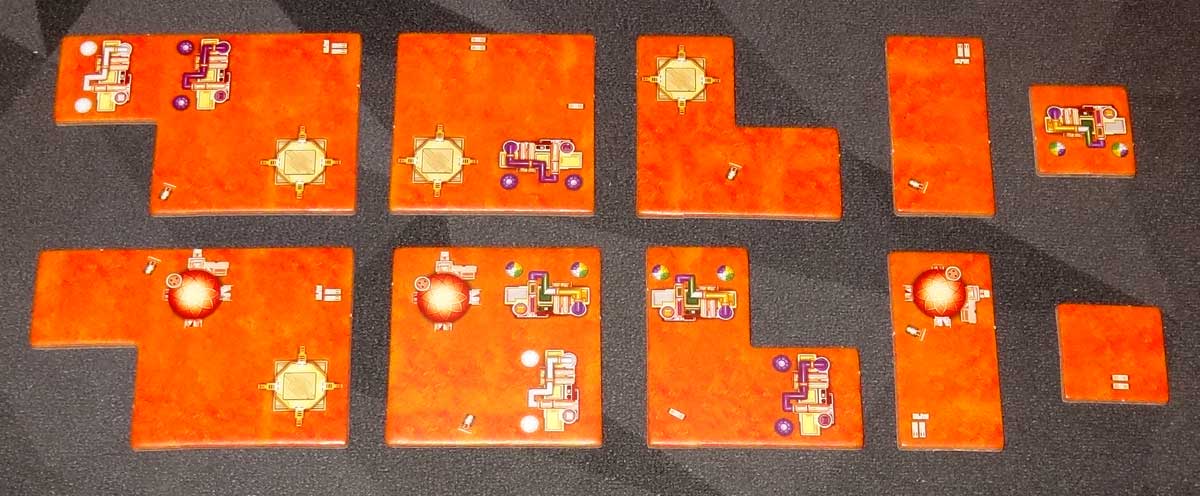
The player board and the development tiles look like a top-down view of the colony and various buildings. There are little boxes and equipment shown on the “empty” spaces as well, just for flavor, which don’t have any game significance. They help to break up that expanse of orange—just be sure to tell your players that they don’t do anything.

The only complaint I have about the appearance is that, since the tiles are orange and the main game board is primarily orange, the tiles blend into the board when you’re choosing sets of resources. I don’t know if the colors will be tweaked at all in the final printing, but I would find that helpful if the main game board was a little more different from the tiles.
How to Play Mining Colony
You can download a copy of the rulebook from BoardGameGeek.
The Goal
The goal of the game is to score the most points through resources, buildings, and structures in your colony.

Setup
Place the main board in the center of the play area, with the shuffled stacks of tiles on the left side of the board. Shuffle the resource cards and place them nearby. Place the remaining components nearby in a supply; the number of each structure (outposts and science stations) will be 1 fewer than the number of players.
Give each player a colony board and a set of excavation cards, which should be shuffled and placed face-down.

Gameplay
The game will last 10 rounds, as you play through the deck of resource cards.
At the beginning of each round, flip over the next resource card, and place tiles and resources onto the main board according to the card. (Note: you’ll only use one space per player, so in a 2-player game you would only fill spaces 1 and 2.)

Each player draws 3 excavation cards from their own deck, and chooses one as their bid for the round, placing the other two at the bottom of their decks. Everyone reveals their choice simultaneously. From highest to lowest excavation card, each player chooses one of the resource sets and takes all of the components in it.

The tile you collect must be placed onto your colony board or sold (discarded) for 1 credit per square. When you place a tile, it must be touching a developed part of your colony, either the darker orange row at the bottom of your colony board or a previously placed tile. You can’t overlap tiles (or the bottom row of the board), or hang tiles off the edge of the grid.
Resources—workers, ships, and crystals—may be placed onto the appropriate buildings or stored at the top of your colony board, though you only have room to store one of each, where they can be placed onto your colony later. Workers are placed in domes, ships are placed on launch pads, and crystals are placed on the storage units that match their color. Each building can hold only 1 item, and once placed, they cannot be moved. You may also sell unplaced resources back to the supply for 1 credit each. (Note that you may only store 5 credits on your board.)

You may also buy build-over tokens for 1 credit each. These can be built over any developed space (on a tile or in that dark orange row) as long as it doesn’t have a resource on it.
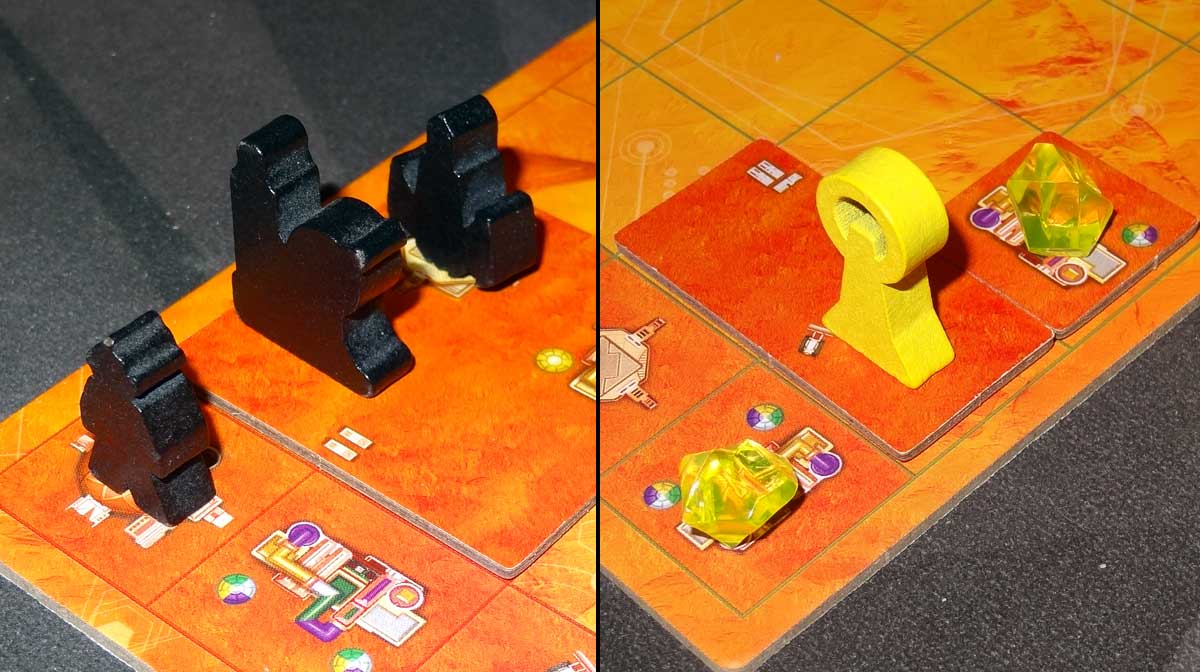
The outposts and science stations are considered structures, and may be built if you meet specific requirements. An outpost is built on an empty developed space between a worker and a ship of the same color. A science station is built on an empty developed space between two crystals of the same color. If two players attempt to build the same structure in the same round, the player who had the higher excavation number for that round gets priority.

Game End
The game ends after 10 rounds, when you’ve run out of resource cards. Everyone scores their own colony as follows:
- Every structure (outposts and science stations) is worth 2 points.
- Every worker, ship, and crystal in your colony (not in storage) is worth 1 point.
- Every 2 credits scores 1 point.
- Every undeveloped space (not covered with a tile) on your colony board is -1 point.
- Each player will have 2 unused excavation cards. The player with the highest sum scores 6 points, second-highest scores 3 points, and third-highest scores 1 point. (In case of a tie, the player whose lower-valued card is higher wins.)
The player with the highest score wins, with ties going to the player with the highest total unplayed cards.
Solo Rules
The solo variant is set up like the 2-player game, but without the second board. You’ll compare your excavation card to one drawn from another deck; if the other card is higher than yours, the automated player “Zorlord” will choose first, taking a set based on whether their card was odd or even. You may spend credits to trade items with Zorlord, and you may also spend 1 extra credit to build a build-over token on an undeveloped space.
The goal is to build one structure of each color and completely develop your colony before the end of 10 rounds; the difficulty level can be tweaked by increasing the cost of the build-over tokens.
Why You Should Play Mining Colony
I described Mining Colony as a tile-laying game, but it’s not just that. It’s also a packing game, because you’re trying to fill up your colony board as much as possible. It’s also an auction game, since you bid (in a way) for the various sets of resources. And it’s a puzzle, as you try to set up combinations so you can build structure, which are worth the most points.
Packing games are great for the sort of person who likes playing Tetris: they scratch that particular itch you have for filling up a space just perfectly with irregularly shaped pieces. In the case of Mining Colony, though, the tiles range in size from 1 to 5 squares, which can make planning for open spaces a little trickier. That’s not even taking into consideration the fact that you want to arrange domes, launchpads, and storage units so that you can build structures.
Just because a perfectly-sized tile is available on the main board doesn’t mean you’re going to get it, either. That’s where the bidding comes in. Mining Colony simplifies things a little because you only have three possible bids per round, from a randomly drawn hand of cards. In some cases, your cards will be pretty close to each other so it might not matter so much, but in others you might have really low and really high numbers. The thing is, you’ll cycle through your deck more than once, so the cards you don’t use will reappear later. Plus, there’s a bonus for the player who has the highest sum leftover (basically, the person who “spent” the least), so that can also affect how much you’re willing to bid for a particular set of resources.
Now, I’m typically terrible at auction games: I overbid on things that nobody wants, and don’t bid high enough for things that could really benefit me. That still happens to me a bit in Mining Colony: in one game with my family, I kept playing my middle card at a time when everyone else happened to have even higher low cards—but then when I played my highest card, I could have won with a lower card.
The sets of resources aren’t equivalent—it’s a random assortment of tiles and resources, but depending on the particular tiles, you might have a 1-square tile with nothing on it paired with a single crystal, and larger tile with two buildings paired with resources that just happen to match those buildings. Some things will be more valuable to you based on what you’ve already built, but larger tiles fill your board or can be sold for more credits. It’s pretty tricky to decide when to bid high and when to let somebody else pick first.
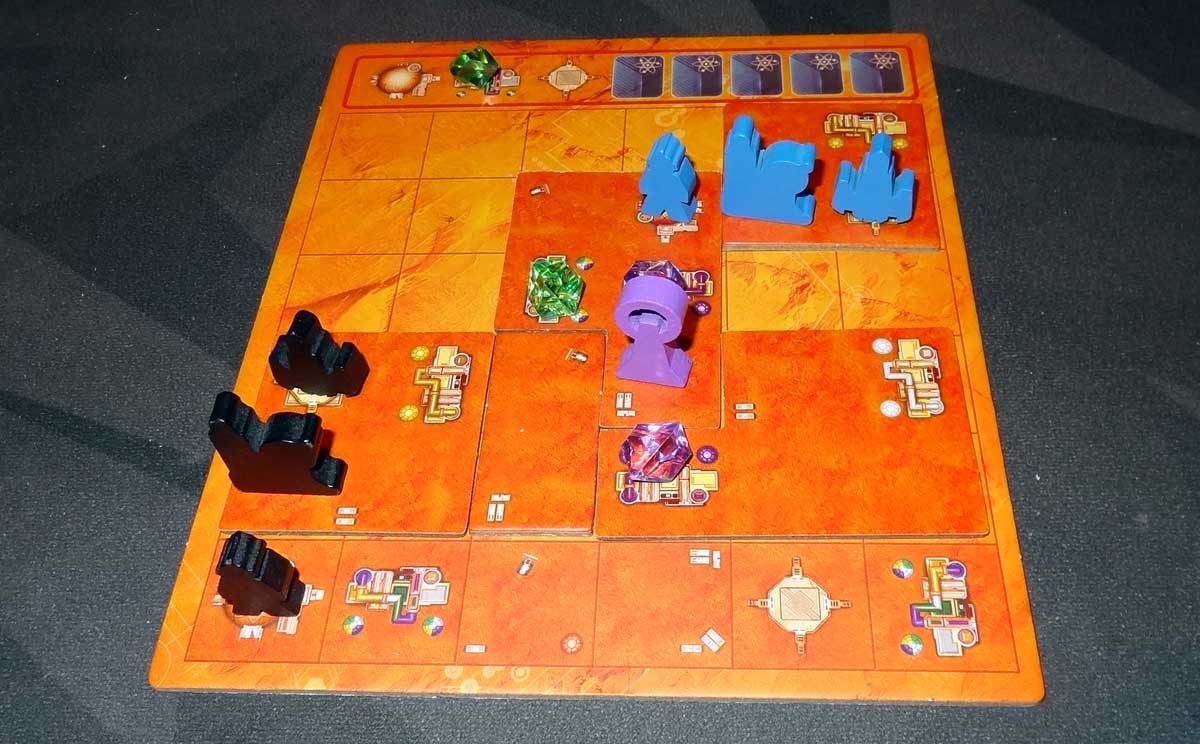
The structures have a big effect on tactics, since they’re worth more points and there aren’t as many of them. It’s a race to build them first—which might make you take a set of resources that’s smaller, just because it has the right color ship. Or, you might place a tile in a less efficient orientation because it lines up a dome and a launchpad. The build-over tokens can help get things set up (including building a blank space over another building to make room for a structure), but they cost credits, so you have to give up something to earn those.
Mining Colony is a pretty quick game: it’s very easy to learn the rules, and it doesn’t take too long to play. But there’s enough going on to make it a satisfying experience, building out your own little corner of the planet. I like the fact that you can’t directly affect somebody else’s colony, but there’s still plenty of player interaction in the competition for the resource sets and the structures. Steve Finn has often been described as “the king of fillers” because his games tend to be shorter, casual games (like Herbaceous, Sunset Over Water, and The Whatnot Cabinet); but don’t let that fool you. They may be shorter and easier to learn, but they’re not simplistic, either. It’s not Terraforming Mars, but it’s one that I can play with just about anyone.
For more information or to make a pledge, visit the Kickstarter page for Doctor Finn’s 2021 lineup!
Click here to see all our tabletop game reviews.
![]() To subscribe to GeekDad’s tabletop gaming coverage, please copy this link and add it to your RSS reader.
To subscribe to GeekDad’s tabletop gaming coverage, please copy this link and add it to your RSS reader.
Disclosure: GeekDad was loaned a prototype of this game for review purposes.
